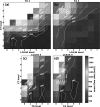Influence and interactions of laryngeal adductors and cricothyroid muscles on fundamental frequency and glottal posture control
- PMID: 25235003
- PMCID: PMC4188037
- DOI: 10.1121/1.4865918
Influence and interactions of laryngeal adductors and cricothyroid muscles on fundamental frequency and glottal posture control
Abstract
The interactions of the intrinsic laryngeal muscles (ILMs) in controlling fundamental frequency (F0) and glottal posture remain unclear. In an in vivo canine model, three sets of intrinsic laryngeal muscles-the thyroarytenoid (TA), cricothyroid (CT), and lateral cricoarytenoid plus interarytenoid (LCA/IA) muscle complex-were independently and accurately stimulated in a graded manner using distal laryngeal nerve stimulation. Graded neuromuscular stimulation was used to independently activate these paired intrinsic laryngeal muscles over a range from threshold to maximal activation, to produce 320 distinct laryngeal phonatory postures. At phonation onset these activation conditions were evaluated in terms of their vocal fold strain, glottal width at the vocal processes, fundamental frequency (F0), subglottic pressure, and airflow. F0 ranged from 69 to 772 Hz and clustered into chest-like and falsetto-like groups. CT activation was always required to raise F0, but could also lower F0 at low TA and LCA/IA activation levels. Increasing TA activation first increased then decreased F0 in all CT and LCA/IA activation conditions. Increasing TA activation also facilitated production of high F0 at a lower onset pressure. Independent control of membranous (TA) and cartilaginous (LCA/IA) glottal closure enabled multiple pathways for F0 control via changes in glottal posture.
Figures










References
Publication types
MeSH terms
Grants and funding
LinkOut - more resources
Full Text Sources
Other Literature Sources
Research Materials

